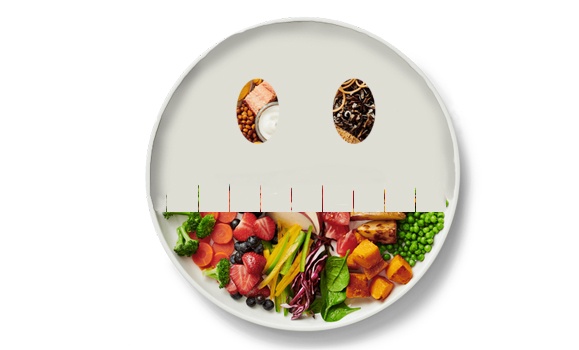Dentistry and dental hygiene students in the AVĺ„ņ÷≤Ņ Faculty of Dentistry are taught nutrition according to the guidelines found in Canada‚Äôs Food Guide. That means the launch of the latest version ‚ÄĒ the first re-write since 2007 ‚ÄĒ¬†is like introducing a brand-new textbook. And that‚Äôs a good thing, even though the course will need to be revamped to reflect the changes.
Prof. Heather Doucette in the School of Dental Hygiene and Dr. Mary McNally, assistant dean of research and professor in the Department of Dental Clinical Sciences, teach nutrition to students in the Faculty of Dentistry. They feel that is the best source of nutritional advice available to them.
How nutrition affects oral health
‚ÄúIt is what the government of Canada recommends for a healthy diet, based on evidence from a large team of experts,‚ÄĚ says Dr. McNally. ‚ÄúIt makes sense to use it to promote good oral health. I‚Äôm particularly happy to see that the new version contains oral health information and makes the connection between good oral health and good overall health.‚ÄĚ
‚ÄúThe course I teach, Nutrition for Preventative Dentistry, is a basic theory course about how nutrition affects oral health,‚ÄĚ says Prof. Doucette.
Students not only need to know what impact different foods and nutrients have on oral health, but they need to be able to counsel their patients. ‚ÄúI normally ask my students to analyze their own diets according to Canada‚Äôs Food Guide,‚ÄĚ says Prof. Doucette. ‚ÄúHow many fruits and vegetables are they eating, how much milk and grains? I also ask them to look at specific nutrients, such as calcium, vitamin C, and iron, and compile this information in a food diary. It helps them understand what a healthy diet is and where their diets may be falling short.‚ÄĚ
In turn, the students ask their patients about their diets by looking at what they ate over the past 24 hours. ‚ÄúIt gives the students a snapshot of what a patient‚Äôs diet might be like and enables them to make recommendations that will improve their oral health.‚ÄĚ
Connecting oral health to overall health
Both Dr. McNally and Prof. Doucette welcome many of the changes to the new Canada’s Food Guide, particularly specific references to oral health and its connection to overall health.
‚ÄúI‚Äôm pleased to see that water is being promoted as the drink of choice and that there is a move away from juice, which previous guides suggested could be treated as a source of nutrients,‚ÄĚ says Dr. McNally.
‚ÄúI love that the new guide is promoting water and urging people to limit sugary drinks, including sports drinks, which youth often gravitate to,‚ÄĚ says Prof. Doucette. ‚ÄúDrinks that are acidic and sugary have a bad effect on teeth, which in turn affects the rest of our health, particularly when we consider the nutrients we could be consuming.‚ÄĚ
In the new food guide, the familiar rainbow of four food groups ‚Äď fruits and vegetables, grain products, dairy, and meat, fish, and other proteins ‚Äď has been replaced by a single plate, half of which is filled with fruits and vegetables, with the remaining quarters devoted to proteins and whole grains.
Careful about calcium
Dairy products no longer have their own group in the new Canada Food Guide. Instead, they fall under the protein umbrella. Both professors question whether the change of emphasis could have an adverse effect on people‚Äôs consumption of calcium, which is essential for the development of bones and teeth. Dr. McNally also points out that it is the ‚Äúsingle, most high- quality source of protein for children‚ÄĚ.
‚ÄúOne thing that concerns me,‚ÄĚ says Prof. Doucette, ‚Äúis that people often aren‚Äôt aware of other foods that contain calcium. There aren‚Äôt many ‚Äėgrabbable‚Äô calcium sources featured in the new guide.‚ÄĚ
Grabbable sources include a glass of milk, a piece of cheese, or a pot of yoghurt. They provide not only calcium, but vitamin D (frequently added to dairy products), which helps the body to absorb calcium. Less readily grabbable calcium sources would be tofu, sardines, beans and lentils, and seeds.
Prof. Doucette points out that the document that is ultimately distributed to the general public could make an important difference to the way people interpret the new food guide. ‚ÄúIt will be the job of that document to make the new guidelines applicable on a daily basis.‚ÄĚ
Overall, both Prof. Doucette and Dr. McNally welcome the inclusion of specific oral health information, a first for Canada’s Food Guide.
Read also: In defence of Canada's food guide
Sara Kirk, a professor of health promotion at AVĺ„ņ÷≤Ņ and one of the academic advisors consulted for the new Canada‚Äôs Food Guide, says that the specific mention of oral health is an important one from the perspective of promoting healthy populations.
‚ÄúIt has long been acknowledged that oral health is an indicator of overall health and wellbeing. Indeed, the World Health Organization and other international agencies have been calling for action to address the underlying determinants of oral health,‚ÄĚ says Dr. Kirk. ‚ÄúSeeing these links clearly articulated in the new guidance should help to elevate our understanding of the relationship between the oral and overall health of populations.‚ÄĚ

